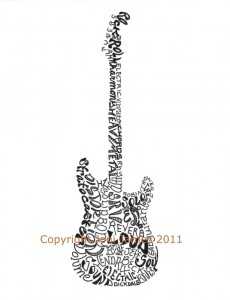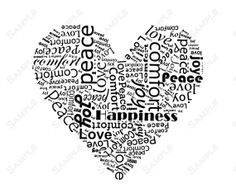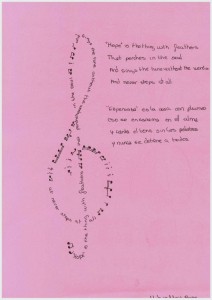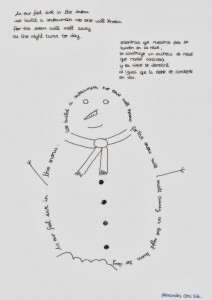Hello Explorers!
This week, my middle group had a great Poetry Workshop, and one of the activities that Raquel proposed us, had to do with the creation of Shape Poetry. In this case, we had to find inspiration using a model that she provided, and there where up to six different types of shape poetry for us to explore.
But, what is shape poetry? in Spanish we know it as caligrama, and according to Wikipedia, it is
A poem, phrase, or word […] arranged in a way that creates a visual image. The image created by the words expresses visually what the word, or words, say. In a poem, it manifests visually the theme presented by the text of the poem.
In my opinion, it is a great resource to present poetry to our pupils in a different way to the ‘create two verses that rhyme’. It is very visual, catchy and interesting. In this case, the poem can be enjoyed not only by listening to, or reading the words, but also by understanding the message that the picture is provoking.
It could be said that the words layout provide a visual clue to understand the poem. Moreover, it can engage those students whose visual-spatial intelligence is more developed than their linguistic intelligence, as they can create poems using few words.
Here you can find some examples taken from the blog “El baúl de las palabras”, created by a literature teacher from IES Federico García Lorca, in La Puebla de Cazalla (Sevilla). They are the proof that, with the proper guidance, pupils or young students can create beautiful poetry.
Furthermore, there are some artists who are able to create amazing designs, such as those by Joni James, in which she uses the names of the parts of the object she is ‘drawing’ to recreate it, as you can see on the bicycle, or words related to the topic, as in the guitar and the heart.


 The next question is, can it be used in the classroom with Primary Education pupils? I would say yes. Although the examples above are more elaborated, there are simpler ideas (like the ones we created in class), that can help us teachers, to introduce poetry in the classroom in a really enjoyable and catchy way.
The next question is, can it be used in the classroom with Primary Education pupils? I would say yes. Although the examples above are more elaborated, there are simpler ideas (like the ones we created in class), that can help us teachers, to introduce poetry in the classroom in a really enjoyable and catchy way.
I hope you like the post. I encourage you to explore the topic, and also to have a look at Joni James’ gallery, where you will find authentic works/words or art.
Have a nice week!
Sources:
Blog “El Baúl de las palabras”. IES Federico García Lorca (La Puebla de Cazalla, Sevilla) http://lorcaelbauldelaspalabras.blogspot.com.es/2014/02/caligramas-en-ingles.html
Joni James Calligrams https://www.etsy.com/es/people/jonijames
Wikipedia (Definition of Calligram) http://en.wikipedia.org/wiki/Calligram


Hello Loli! I have found your post very clear and interesting and I have chosen it to comment on because I completely agree with you.
I think you are right; using poetry with our pupils in a different way is something interesting and definitely a great resource! Pupils can feel more motivated because they are working with something visual, not only with words or sentences. Moreover, as you said in you post, we could link the content of poetry with the ‘picture’ that it is representing. Therefore, they can learn how to interpret this shape poetry.
Furthermore, the fact of working on different intelligences is very positive because not all pupils work in the same way and we should attend to diversity in our class.
Last week, when we created some shape poems in class, I felt very enthusiastic and I created an apple in order to make easier to understand the poetry, which was about ‘Snow White and the Three Stooges’. Due to this reason, I consider children can not only read these shape poems but also create or complete them. Doing that, we are fostering imagination and creativity at the same time we work on poetry, something that is essential in pupils of this age.
By and large, regarding your question; yes, I strongly feel that it can be used in schools with Primary Education pupils.
Bye!
Hi Eva, and thanks for commenting
Believe it or not, it was your apple that I had in mind when I decided to write this blog entry. To be more concrete, the apple and my own feeling when I knew that we had to create. So exciting!
I am glad to see that we think the same about the possible applications of shape poetry in the Primary classroom.
Hello Loli!
Today it was our turn to do our own poems with this technique “shape poems”. As you said I also think it is a good way to encourage our students to read poetry. It is a way to show them that poetry is something more than beautiful words with a rhyme. We can ask them to do a poem using this technique of almost everything. For example, I’m thinking on landscapes, favorite objects, food, seasons of the year…
I have to add that with this technique, we are not working only on producing poems but also creativity in a more visual way. In my opinion, children feel more attracted to catchy and visual things; we have to take this into account and using it as an advantage. So if this is something that can call the attention of our students to read and produce poetry, why not using it?
Hi Elena
I agree with you, when you say that poetry is more than beautiful words and rhyme. Shape poetry gives also a chance to children and adults who are not aware of the ‘emotional’ side of words, because it makes poetry something tangible.
Thanks for commenting!
Hello Loli,
First of all , I want to say that I have been looking the blog and I like a lot. Then I want to answer to your question and I say yes, completly yes. In my opinion, this kind of poems you can work perfectly with students of Primary education. You can use different levels depending on the age of the students but I am sure that it could be work perfectly and it could be like a lot.
On the other hand, I like very much your poems with shapes that you have chosen to show us specially the snowman.
I know that you have a lot ideas related with this and i am sure that if you use this poems in your class it will be succesful.
Thank for your post.
Hi Luis, thanks for commenting
I am glad you liked the pictures that support the text, it means that I chose the good ones. For me, it is clear that this type of poetry needs to have a relevant place in our lessons, because it can be greatly motivating for our students.
Nice post,Loli. Shape poems are a wonderful resource when you want to review key vocabulary on a topic or when you elicit students’ prior knowledge. As you said, it engages students quickly and makes use of their visual intelligence. Glad you liked the session!